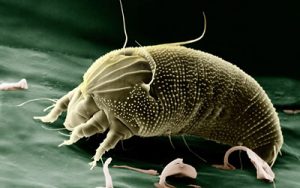Many people in Ireland recognize allergy symptoms such as a runny or stuffy nose, itchy, watery eyes and sneezing (allergic rhinoconjunctivitis) from dust exposure related to common household chores such as vacuuming, sweeping, and dusting. House dust exposure can also trigger asthma symptoms such as wheezing, coughing, chest tightness and shortness of breath.
If you think you may have an allergy to any of the components of house dust, consult a board certified allergist-immunologist. To pinpoint the cause of your symptoms, the allergist will ask detailed questions about your work and home environments, family medical history, frequency and severity of symptoms, exposure to pets and a variety of other questions. Sometimes the history will reveal obvious triggers, like someone who develops symptoms every time they are around a certain animal. More often though, the history may suggest triggers, but it may not be obvious in identifying the exact ones.
Sometimes the medical history may not suggest any triggers, yet allergy may be the cause. In this case, your allergist finds out what you are allergic to by doing skin tests. Skin tests involve either pricking the skin (prick tests) or injecting into the skin (intradermal tests) with different allergens and observing for a reaction. A positive reaction (a raised welt with redness around it) may indicate that you are allergic to that allergen. Occasionally, your allergist may order a blood test in addition to the skin test to confirm the diagnosis of allergy. The blood tests are generally less sensitive than skin testing.
Dust allergy treatment
Once your allergy triggers have been identified, steps should be taken to avoid them. Research has confirmed that targeted avoidance (environmental control aimed at relevant triggers) can be as effective as medications in reducing symptoms. The usual case requires targeted avoidance, medications prescribed by your allergist, and in many cases, specific allergen immunotherapy (allergy shots) to bring the problems under control.
Dust mite allergy
Dust mites in Irish beds (sometimes called bed mites) are the most common cause of allergy from house dust. They belong to the family of eight-legged creatures called arachnids that also includes spiders, chiggers and ticks. Dust mites are hardy creatures that live and multiply easily in warm, humid places. They prefer temperatures at or above 70 degrees Fahrenheit with a relative humidity of 75 percent to 80 percent. They die when the humidity falls below 40 percent to 50 percent. They are not usually found in dry climates.
High levels of exposure to dust mite in Irish properties are an important factor in the development of asthma in children. People who are allergic to dust mites react to proteins within the bodies and feces of the mites. These particles are found mostly in pillows, mattresses, carpeting and upholstered furniture. They float into the air when anyone vacuums, walks on a carpet or disturbs bedding, but settle out of the air soon after the disturbance is over.
Dust mite-allergic people who inhale these particles frequently experience allergy symptoms. There may be many as 19,000 dust mites in one gram of dust, but usually between 100 to 500 mites live in each gram. (A gram is about the weight of a paper clip.) Each mite produces about 10 to 20 waste particles per day and lives for 30 days. Egg-laying females can add 25 to 30 new mites to the population during their lifetime.
Mites eat particles of skin and dander, so they thrive in places where there are people and animals. Dust mites don’t bite, cannot spread diseases and usually do not live on people. They are harmful only to people who become allergic to them. While usual household insecticides have no effect on dust mites, there are ways to reduce exposure to dust mites in the home.
Why does house dust cause allergic reactions?
House dust is a mixture of many substances. Its content may vary from home to home, but the most common allergy triggers are:
- Dust mites
- Cockroaches
- Fungi (Mold)
- Animals
Any of these allergens can cause a response in the immune system which results in the production of a special antibody (Immunoglobulin E or IgE). IgE brings about an allergic inflammatory response. Exposure to only small amounts of the offending allergen can cause allergy symptoms.
Tips for reducing house dust allergens.
1. Measure the indoor humidity and keep it below 55 percent. Do not use vaporizers or humidifiers. You may need a dehumidifier. Use vent fans in bathrooms and when cooking to remove moisture. Repair all water leaks. (Dust mite, cockroach, and mold allergy.)l
2. Remove wall-to-wall carpets from the bedroom if possible. Use a central vacuum or a vacuum with a HEPA filter regularly. If you are allergic, wear a N95 filter mask while dusting, sweeping or vacuuming. Remember, it takes over two hours for the dust to settle back down, so if possible clean when the allergic patient is away and don’t clean the bedroom at night. (Mold, animal and house dust mite allergies)
3. Keep pets out of the bedroom at ALL times. Consider using a HEPA Air Cleaner in the bedroom. It is best to remove the animal from the home. (Animal allergy.)
4. Encase mattresses and pillows with “mite-proof” covers. Wash all bed linens regularly using hot water. (Dust mites allergy.)
5. Do not leave out uncovered food at night. Dispose of food wastes (including fast food wraps) in a tightly sealed garbage can. Use roach traps. Schedule regular professional pest control utilizing integrated pest management (IPM) methods. (Cockroach, mouse and mould allergy.)
6. Install a high efficiency media filter with a MERV rating of 11 or 12 in the furnace and air-conditioning unit. Leave the fan on to create a “whole house” air filter that removes particulates. Change the filter at least every three months (with the change of the seasons) to keep the air cleaner year round. Have your heating and air-conditioning units inspected and serviced every six months. (Animal, mold and house dust mites allergies.)
7. Your board-certified allergist is the best resource for effective help with these issues. Many expensive, unproven products are of no benefit.
Is dust allergy a sign of a dirty house?
No. A dirty house can make a house dust allergy problem worse, however. Normal housekeeping may not be enough to get rid of house dust allergies. This is because many of the substances in dust cannot be removed by normal cleaning procedures. Vigorous cleaning methods can actually put more dust into the air making symptoms worse. Even if the house is very clean, some people are so allergic to dust that even minimal exposures may trigger their symptoms.

